#Anti Max Hastings
Explore tagged Tumblr posts
Note
I think we need to start an anti-Max Hastings club or something bc the fics/posts are getting out of hand and i need to know there are still sane people about 😭
Literally so real. If I see one more MaxPip fic (which is extremely likely, because that weirdo who posted the one based on Guilty as Sin said they're posting another part soon), I'm gonna lose it. I just do not understand how hard it is to understand that Max shouldn't be romanticised? He's a fucking freak. But I guess people will go crazy for a shirtless blond guy, even if he's a fucking rapist 🙄
Yes, we need to start an anti Max Hastings club ��� anyone who's actually read the books + watched the show with their eyes open would join the club because no sane person should like Max Hastings and/or ship him with Pip 😭
#agggtm#a good girl's guide to murder#max hastings#anti max hastings#max hastings drop dead asap#max hastings you're an ugly loser#and anyone who likes Max is a freak#don't like calling others freaks but there's an exception this time#max hastings lovers are freaks
22 notes
·
View notes
Text
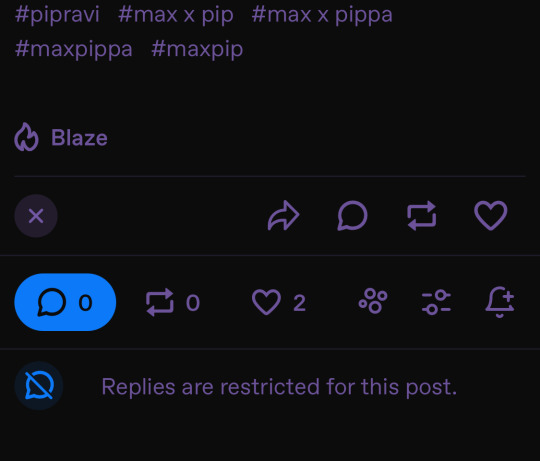
Hm yeah i wonder why
#Max hastings supporters read the fucking book you claim to like challenge (level: impossible)#Anti Max hastings#agggtm#a good girls guide to murder#MAX HASTINGS IS LITERALLY A FUCKING SERIAL RAPIST DUDE#pippa fitz amobi#pipravi
11 notes
·
View notes
Text
I've been seeing a lot of max hastings stans lately saying that he's an "interesting" character despite his actions so I'll bring here exactly what I posted on twitter.

#this isn't some fantasy show that's full of war criminals or morally grey characters or something#max isn't interesting or complex he's a straight up rapist he's WRITTEN to be a rapist and meant to be hated#if you genuinely like him bc of his “character” then that's fucking insane bc he has NO character#agggtm fandom i fear it will get so much worse once the show is released#agggtm#a good girl's guide to murder#max hastings#anti max hastings#nav agggtm
13 notes
·
View notes
Text
Live footage of me at 1 am in the middle of a 40 plus hour PD work week but I must write the blorbos and not be silenced

#im so exhausted and sleep deprived#but im a woman on a mission#my sworn duty#to piss off antis even more akdkf#a good girls guide to murder#agggtm#max hastings#pippa fitz amobi#max x pip#max x pippa#maxpip#otp: down the hatch#dead dove do not eat#dark ship#i feel like tht dw meme but i carry on
5 notes
·
View notes
Text
Haunting
Whumptober Day 10: "Can't you see that you're lost without me?"
No matter where Chase goes, the shadow follows.
He's ditched his car and three others in the last day, driving the gas tanks down to their last dregs in his haste to get away. He doesn't have a destination in mind other than away, yet with each mile down the unforgiving highway, the chill down his spine rankles him even more.
He slaps his hand over the back of his neck, like the sting would make the crawling fade away.
"There aren't any more cameras," he mutters under his breath. "I'm safe now. It's fine."
But how can he be so sure? Ever since those freaky scientists guys were murdered, he's had to hop between towns, losing the trail of whatever people or things want to find him. He hasn't heard from Echo since he escaped IRIS. He has no idea what the public knows about him. (Would IRIS send out a manhunt? Do people think he's a criminal?) He has no sense of where to go or what to do but survive.
Why couldn't this have been a misunderstanding? Why didn't they let him go home?
What does Anti want from him?
The ghost of a breath sends a shiver down his spine, and he cranks the heat in the current old beater to the max. It sputters out a smog of hot diesel from the exhaust; his face screws up at the stench.
He's been in this rustbucket truck for too long. Hopefully the more inland he goes, the easier it'll be to find a rural town to swap cars. The sooner he can find a gas station without CCTV, let alone a WATCHR, the better.
Except the beater doesn't get him that far.
Something rattles under the hood, and a plume of smoke sparks and slithers out through the cracks. Chase curses and slams the steering wheel and pulls over three miles before the next exit, then grabs his meager belongings and sprints away as he hears a resounding boom and a rush of heat scorches his back.
It exploded. The truck fucking exploded.
With his heart in his throat, Chase reaches for his back pocket and nearly falls over in relief. The picture is still there. Even after everything, he hasn't lost it. He can't.
"For someone trying to avoid me, you put on quite the show."
Chase lurches and goes for the gun in his waistband, only to jolt when he comes up empty. It must still be in the center console, melting into a mangled mess with the rest of the scorching hot metal in front of them.
His hands flex and curl into fists. He doesn't want to turn around, to face the nightmare ruining his life, but if he doesn't, it would give it all the opportunities to stab him or snap his neck, like it had with the bodies it dropped right before they started this race.
"How are you here?" Chase asks. "How do you keep finding me?"
Anti's eyes light up with an eerie white glow. "Do you think it's hard?" it says. "I've followed you from the first time you called my name, the first time you saw this face. You've only been able to run because I wanted to chase."
Chase's breath sharpens. There truly is no getting away, is there? He's crossed half the country in the past few days, and yet no matter where he goes, Anti or IRIS will always find him.
"Why me?" He hates the pleading strain in his voice, but it never seems to fall away. "Why do you want me?"
Anti grins. "You still know nothing, don't you? Those people wanted to use you, but they didn't put in the effort to teach you."
Flames spark in Chase's chest, and despite the autumnal chill, the heat from the truck fire drips sweat down his back.
"Teach me what? I want some fucking answers."
"What will you pay to get them?"
Chase balks. "Huh?"
"You heard me," Anti says. "There's a price for answers, Chase--a price for every choice you made. What will you pay to earn the answers you want?"
He bites his cheek. His wallet got confiscated the second IRIS got their hands on him. The now-unusable gun had been picked off the corpse of an agent that Anti killed on its rampage through the facility. His phone and whiskey were lost before IRIS nabbed him. He has nothing of any value to give.
Anti's smile cools. Those dark, dead eyes bore into Chase's skull.
"Stubbornness won't save you, Chase. Refuse, and you'll stay on the run, forever looking over your shoulder until the maggots put you down. You're a danger, and if you're no use to them, you won't survive. I won't save you a third time."
Chase chokes. "A third?"
Anti's voice lowers, regaining some of the rasp it once had, before the gaping wound on his neck disappeared without a sign of its existence. "Make your choice."
The picture burns a hole in Chase's pocket. Other than the tattered, filthy clothes streaked with blood, dirt, and sweat, it's the only thing he has left to his name. The only tie he has to the person he once was. The only sign that before IRIS, before Anti, Chase had a life. He had something to return to, to live for.
What use is a memento of the last light of his life when it's flickered out?
He pulls out the polaroid and burns the image into his retinas, searing into his memory the bright, joyful, loving faces of his family. He kisses the image as a final goodbye, then offers it like a lifeline.
"It's all I have."
Anti studies the picture, studies every inch of Chase's face, and studies the hand reaching out to him. He slips the picture away and clamps a hand over Chase's.
"You made the right choice, Chase. Welcome home."
@seaswalllow @asteriuszenith @pixie-in-trebleland
#jacksepticeye#antisepticeye#chase brody#writersofjack#River's Writing#Happy birthday Anti#It's been way too long since I've a) written and b) posted anything for this fandom#But hello :]#I am back :]#I can never miss this boy's birthday ;)
44 notes
·
View notes
Text

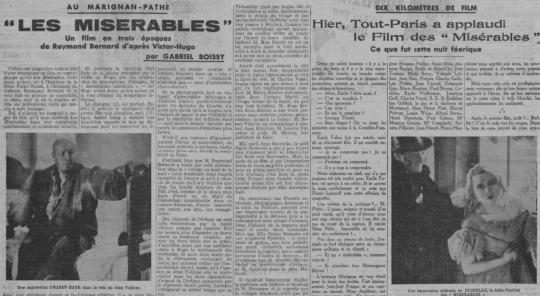
Comoedia, 5 February 1934 (note the picture of Harry Baur by the masthead!) So I learned that the 1934 Les Mis film premiered two nights before a far-right anti-government riot! And you can feel that there was a crisis about to happen in this account of the movie's premiere:
A rough start to the night: there’s the taxi driver’s strike and there’s the parliamentary crisis. The latest information passed from mouth to mouth and most journalists arrived late, bearing the most recent news. “So Emile Fabre is jumping ship?” [Fabre was the director of the Comédie-Française and was apparently being pressured to leave.] “It’s a scandal!” “It’s disgraceful!” “What folly!” “And who is replacing him?” “George Thomé.” [Thomé was a musician as well as the former director the Sûreté.] “Seriously?! They’re going to be cuffing the Comedie-Francaise.” Emile Fabre makes his entrance, followed by his charming daughter. He is just as soon surrounded and interrogated. “I don’t understand! I don’t understand!” “No one understands.” “There is too much to understand.” Our editor-in-chief, who has not always been fond of Emile Fabre, is spotted by his side; he shakes his hand cordially and I note that Pierre Lazareff [editor-in-chief of Paris-Soir] notes this effusive sympathy. A political star enters!...M. [François] Piétri [briefly the Minister of Finance]…thoughtfully and hurriedly, he passes by on swift feet which recently exercised a wise retreat that was, if I dare say, a step ahead of wisdom. He joins Mme. Piétri….It’s impossible to get him to open up!... Caught up in the commotion of the crowd, I hear this brief dialog between a political columnist and a deputy: “And how are your ‘misérables’ doing?” “They are waiting for their Monseigneur Myriel!” The huge Marignan theater is too cramped for this crowd of guests. Luckily Jean-José Frappa and his second in command, Mme. Audibert, thought of everything, took care of everything… And everyone is able to get to the coat check and find his place easily. Because the taxi strike and political events delayed hundreds of people, who then arrived all at once and with haste, this was not an easy task. Who was there? Tout-Paris...I randomly noted with my pencil: Messueirs Paul Abram, Achard, De Adler, Berneuil, Archimbaud, André Aron, Arnaud, Louis Aubert, Aubin, Kujay, Kertée, Azaïs, Bacré, Barthe, Baschet, Baudelocque, Harry-Baur, Bavelier, Robert de Beauplan, Antonin Bédier, Pierre Benoit, Mme Spinelly, Charles Delac and Marcel Vandal, Léon Benoit-Deutsch, André Lang, René Lehmann, Bellanger, Mag Bernard, Tristan Bernard, Jean-Jacques Bernard, Louis Bernard, Dr. Etiënne Bernard (all the Bernards!)...Bernheim, Bernier, Guilaume Besnard, Bétove, Bizet, Blumsteien, Mme Rocher, Boesflug, Pierre de la Boissière, Bollaert, Bouan, Boucher, Robert Bos, Pierre Bost, Paul Brach, Henry Roussell, Charles Burguet, Pierre Brisson, Simone Cerdan, Henry Clerc, Albert Clemenceau, Pière Colombier, Germaine Dulac,Henri Diamant-Berger, Julien Duvivier,Jean Epstein, Fernand Gregh, Mary Glory, René Heribel, Tania Fédor, Alice Field, Jacqueline Francell, Mary Marquet, Florelle, Marguerite Moreno, Françoise Rosay, Becq de Fouquière, Jean Servais, Vidalin, Maria Vaisamaki, Orane Demazis, Rachel Deviry, Rosine Deréan, Jacques Deval, Christiane Delyne, Renée Devillers, Jean Chataigner, Germaine Dermoz, Léon Voltera, Robert Trébor, our director, Jean Laffray, Lucie Derain, Paul Gordeaux, Jean Narguet, Parlay, Suzet Maïs, Antoine Rasimi, Renée de Saint-Cyr, Jean Toulout, Mady Berry, Yolande Laffont, Jean Max, Parysis, Charles Gallo, Léo Poldès, Jean Fayard, Edmonde Guy, Mario Roustan, Paul Strauss, Cavillon, Emile Vuillermoz, Josselyne Gaël, Charles Vanel, S. E. Si Kaddour ben Gabhrit, the duke and duchess of Mortemart, Madame Henry Paté, Marcel Prévost, Louise Weiss, Alfred Savoir, Henri Duvernois, Paul Gémon, magistrate Maurice Garçon, magistrate Campinchi, Sylvette Fillâcier, Jean Heuzé, Pierre, Heuzé, Mona Goya, Simon-Cerf, W.E. Hœndeler, Georges Midlarsky, Michel, Nadine Picard….and others I must be forgetting…pardon me!....Silence!....
In the glow of the half-light from the screen….there are applause! Not since les Croix de bois has a movie been so highly anticipated and now it is time for the verdict….Raymond Bernard can be sure that the audience is rooting for him. Our eyes are full with light and pretty colors. This Paris night is practically magical…and departing from that magic, we are plunged into the great river of les Misérables, into the furious waters of this social storm. Luckily André Lang and Raymond Bernard have made the trip for us. What contrast! From the spectacle of an elegant and distinguished gathering, we move to the misfortunes of Jean Valjean.
The audience picks up on everything that could be an allusion to the present times. But of all these allusions, one stands out. It’s the lament of two gossips, at the moment when the barricades are rising. “What sad times!” “We’ve barely made it through the cholera…and here is the Republic!” Thunderous applause and mad laughter. When, on the barricades, the Republic calls on us to act, the spectators think of other promised actions which haven’t happened and they forget to applaud. But the whole audience is prodigiously virtuous; whenever a good deed is shown on the screen, when some sentence about the heart graces the white canvas, it is punctuated by applause. After the first film, stop!... Time to eat! There’s a mad dash to the punchbowl. In the haste of this day of crisis and running late, many in the audience did not have time for dinner….the buffet, in the blink of an eye, is emptied and the dry drinks make vindictive and impassioned discussions flow. High and low, here and there, everyone was speaking of the Parliment's chances and the intermission bell sounds in an atmosphere charged with electricity. The two other parts of the film, cut by another intermission, each end with a double ovation for Harry Baur, both in the lobby and in the theater. The little Gaby Triquet is passed from person to person towards a chocolate eclair, which she leaves a trace of on the cheeks of Harry Baur. And then as usual everyone rushes to the coat check. Then we go to the fifth floor of the Marignan building. There, in an unoccupied apartment, dinner waits for us. There are more than a thousand of us around little eight-person tables. Ten thousand meters of film, that will make you hungry! Three orchestras pour out waltzes, tangos, and other tunes, while the masters of the hotel fill up our cups. And that continued to six thirty in the morning, in an atmosphere of charming cordiality as each person attested to the pleasure of seeing French cinema accomplish such a feat. Bernard Natan and Raymond Bernard were too surrounded for me to speak to them. Besides, what could I say to them that they haven’t already heard ten times, a hundred times, a thousand times that evening, which was the apotheosis of cinema and of Les Misérables. -Jean-Pierre Liausu
#les miserables#lm 1934#me trying to learn about the 1934 political situation in France via wikipedia
4 notes
·
View notes
Text
Why is Avi Shlaim recycling ‘Baghdad bombings’ theory?
Why is Oxford professor Avi Shlaim blaming Zionist agents for forcing the Jews out of Iraq with a series of bombings? The answer lies in his new childhood memoir, argues Lyn Julius in The Jewish Chronicle:
Avi Shlaim, a professor of history at Oxford, has been no stranger to controversy, attracting criticism from his fellow academics.
Benny Morris has called Shlaim “sloppy”, and slammed his work for “one-sidedness and plain unfairness.”
Now in retirement, Shlaim has just published Three Worlds: Memoir of an Arab-Jew. This is a personal account of his childhood and teenage years straddling three worlds: Iraq, where he was born, Israel where his family resettled, and the UK, where he has lived since 1966.
Aged five, his was a brutal uprooting from a comfortable Baghdad mansion with servants. At a time of rising antisemitism during the 1948 war with Israel, the family fled Iraq to begin new lives in Israel. His father, a prosperous importer of building materials with influential Muslim friends, was completely undone by the move and his much younger wife, once a society hostess, was forced to work as a telephonist.
The marriage broke down. Young Avi brought his emotional baggage to his Jewish school in London, where a friend testifies to the fact he smuggled in non-kosher burgers to spite the headmaster.
During his academic career, Shlaim became more and more stridently anti-Israel. Today he calls it a “colonial settler state”, even though Mizrahi Jewish communities, now comprising over half of Israel’s Jews, predated the Arab conquest and Islam by 1,000 years or more.
The “Arab-Jew” of the title will raise a few eyebrows: the expression is used by some anti-Zionists who deny Jews from Arab countries a separate identity.
But the plaudits have been flowing from reviewers’ pens for Avi Shlaim’s new book. Eugene Rogan, author of “The Arabs” called it the best book he had read all year.
Max Hastings had this to say in the Sunday Times: “This remarkable upside-down tale… A personal story, not a polemic… provocative… His personal odyssey confers on Shlaim an exceptional authority for his words; he can say things that others of us cannot… his thesis deserves to be considered with respect.”
The thesis in question is that “the Zionists” planted bombs in Baghdad to help eradicate the presence of Jews in Iraq. “The shocking truth about the Baghdad bombings of 1950 -51” blares the title of a review by Justin Marozzi in The Spectator.
But Shlaim’s theory is far from conclusive. The only fatal bombing took place in January 1951 (six weeks before the deadline for legal Jewish emigration from Iraq was due to expire) in the Massouda Shemtob synagogue, then being used by “the Zionists” as a registration centre for departing Jews. Three of the five bombs were planted three months after the emigration deadline had passed and caused no casualties.
It is a mystery why “the Zionists” might have thought it necessary to bomb the synagogue when, by late 1950 a backlog of 80,000 Jews, who had already registered to leave for Israel, were stranded in Iraq. Indeed, the Iraqi government toyed with the idea of dumping these Jews on Israel’s border with Jordan or in the Kuwaiti desert because Israel was not shipping them out fast enough.
All the evidence for the bombings points to the nationalist Istiqlal party as the culprit. An Istiqlal member confessed to an Iraqi historian, Shamel Abdul Kader, that he planted the first bomb in April 1950. The Israeli new historian Tom Segev produced evidence blaming the synagogue bombing on Iraqi nationalists.
Iraqi Jews already had reason enough to seek a haven in Israel – rising pro-Nazi sentiment, the memory of a vicious Baghdad pogrom in 1941, the execution of the wealthy non-Zionist Shafik Ades in 1948, arrests, extortion, racist laws persecuting and dispossessing them. A vibrant community of 150,000 is now reduced to three Jews.
But Shlaim claims there was no antisemitism in Iraq until the Iraqis ‘turned on the Jews’ for their alleged complicity with the British invasion of 1941 and the foundation of Israel.
It is a travesty that Shlaim should not only fail to blame Arab regimes for the mass ethnic cleansing of their Jewish citizens, but that his reputation as an Oxford academic should lend ‘exceptional authority’ and respectability to these highly controversial claims,
What lies behind Shlaim’s anti-Zionism? In reviewing ‘Israel and Palestine’ Benny Morris pronounced himself puzzled.
“Many intellectuals, in Israel as in the West, have been moved by the Palestinians’ history and their plight, but at the same time they have remained sympathetic to Israel’s predicament…. In Israel and Palestine, by contrast, there is no sign of any such complex sympathy.
“For Shlaim, Israel and its leaders can do no right. It all begins to seem very personal. What is the source of this bias and this resentment? ‘
It appears that Shlaim’s memoir holds the answer. Israel is responsible for his unhappy childhood, his family’s impoverishment and his broken home.
Read article in full
More about Avi Shlaim
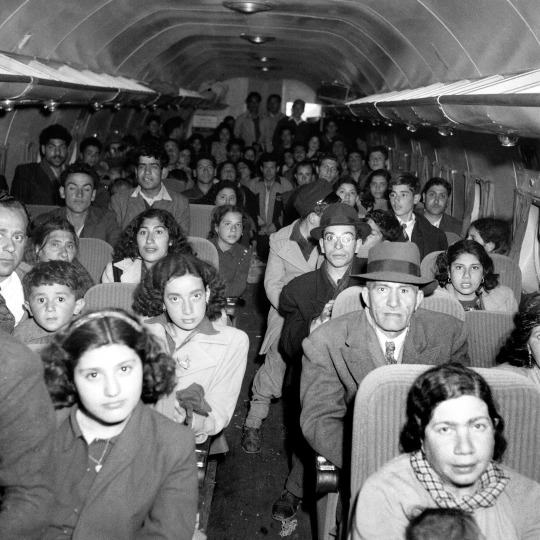
Point of No Return
11 notes
·
View notes
Text

A complex pattern of hedgerows crisscrosses the Normandy countryside.
Soldiers faced some of the toughest obstacles of the war during Operation Cobra: dug-in German troops, terrible weather that frequently prevented air support, and the stubborn French bocage, or hedgerows. World War II-era Normandy was mostly farmland—a patchwork of irregular fields divided by ancient country lanes sunk into the earth after centuries of use. Towering hedgerows guarded each lane, long earthen berms so overgrown with brush and trees they were impossible to see through. The Nazis defended the French interior by using these natural structures as bunkers and barricades. The bocage posed an especially serious problem for advancing Army tanks. The tanks made numerous attempts to drive over them, but as the crested the hilly barriers, their guns would be pointed skyward and their undersides exposed to German anti-tank rockets. But without tank support, Allied forces would be doomed to languish on the Normandy beachheads, unable to penetrate the Axis defense.
Sgt. Curtis Cullin’s hedgerow cutter, or Rhino device, affixed to a Stuart Light Tank, Normandy, 1944. The invention earned its nickname due to the prongs’ resemblance to rhinoceros horns. The most effective solution was also the most famous. Most often attributed to Sgt. Curtis Cullin of the 102nd Cavalry Reconnaissance Squadron, the “Rhino”-tank was a clever repurposing of German defensive hardware. Using scrap steel recovered from a bombed out Nazi roadblock, Cullin fashioned a set of large prongs, shaped like the end of a fork, which he attached to the front of a tank. The tank accelerated up the berm and cut through the thick brush as if it were cardboard.
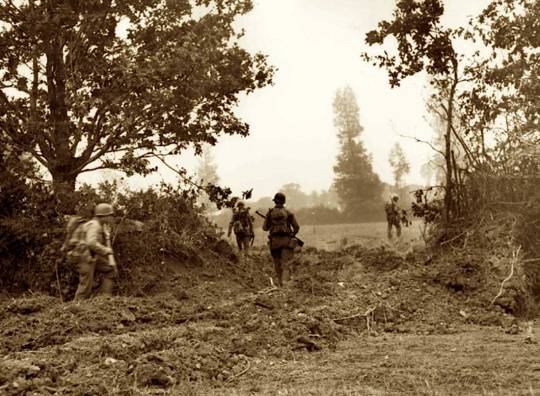
American troops advance through a gap in a hedgerow, carved out by a Rhino tank.
When Gen. Omar Bradley, commander-in-chief of American ground forces during the Normandy invasion, saw Cullin’s invention at work, he ordered them into full-scale production. Soldiers collected the iron anti-tank jacks the Nazis had scattered across Normandy’s beaches and transformed them into hedgerow cutters, which were bolted to virtually every tank in the First Army. Bradley made certain the Rhino tanks were not used until the launch of Operation Cobra. Their effectiveness—further enhanced by the element of surprise—gave the American forces an important morale boost and helped them push deep into German territory. The Rhino tank was so helpful to the invasion that the 29 year-old Sgt. Cullin was awarded the Legion of Merit for its creation.
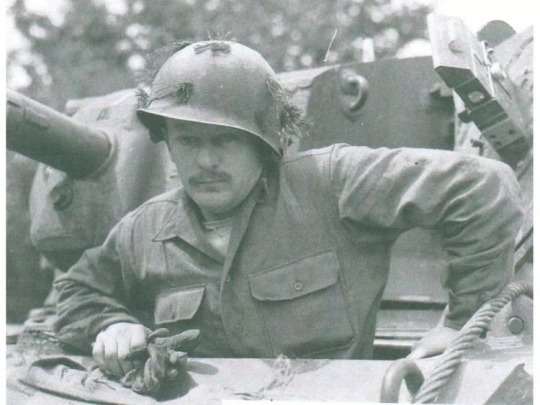
A native of Cranford, New Jersey, Culin was serving as a tanker with the 102nd Cavalry Reconnaissance Squadron (New Jersey National Guard, the "Essex Troop," 2nd Armored Division) when he came up with the four-pronged plow device created from scrap steel from a German roadblock. When attached to the front of his tank it was successful in rapidly plowing gaps in the hedgerows. Military historian Max Hastings notes that Culin was inspired by "a Tennessee hillbilly named Roberts", who during a discussion about how the bocage could be overcome said "Why don't we get some saw teeth and put them on the front of the tank and cut through these hedges?" Rather than joining in the laughter that greeted this remark, Culin realised the idea's potential and put together a prototype tusk-like assembly welded to the front of a tank. In due course this was demonstrated to General Bradley, who "watched in awe as a hedgerow exploded … to make way for the Sherman bursting through". According to Hastings, Culin, "an honest man", attempted to give credit to Roberts but this was forgotten in the publicity surrounding the invention. Hastings concludes: "[Culin] became a very American kind of national hero".
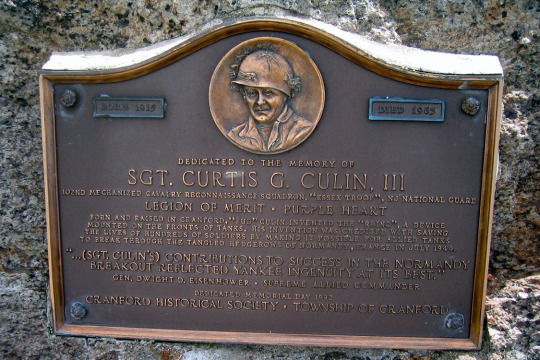
Sources:
HT: @mixrpixr
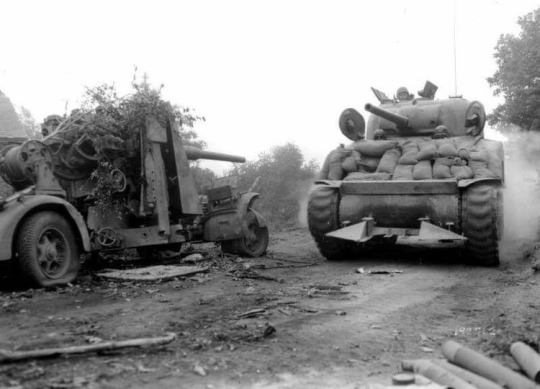

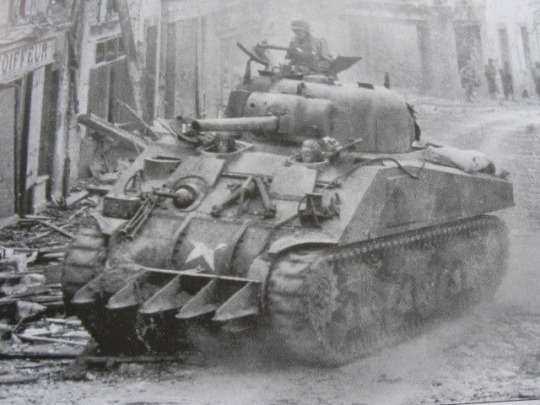
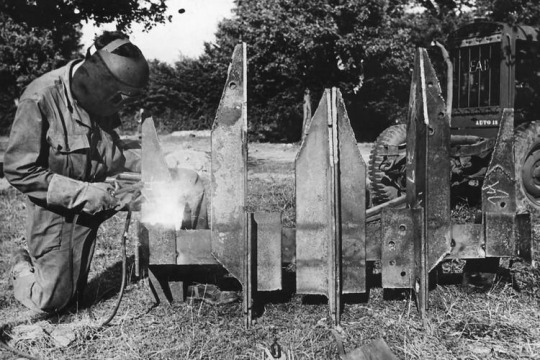
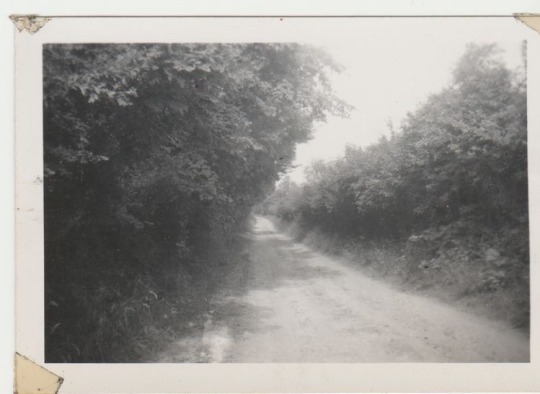
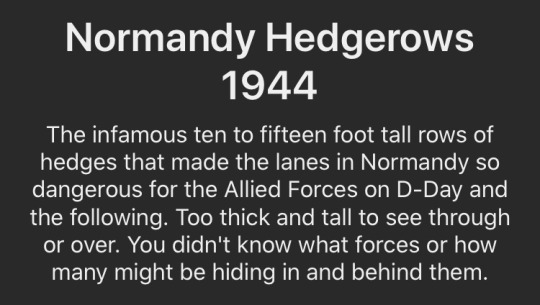
Hedgerow Cutters on Sherman tanks
205 notes
·
View notes
Text
ya know, i wasn’t feeling it in the moment, but looking back and reflecting on it now…pip really should have thrown max under that truck when she had the chance.
#🤷🏼♀️#Idk like it was violent#But I feel like it would have been the best#Then she would have just gotten it over with#Instead of#you know#what she did#pip fitz amobi#max hastings#anti Max Hastings#Agggtm#as good as dead
49 notes
·
View notes
Text
Check in on my (not very realistic) wish list for episode 139
1. Nobody dies in the potential battle against Lucien/the Somnovem? I will be fine with temporary unconciousness but please nobody actually dies? Will they even fight? What was going on with the cliffhanger? I have so many questions!
Hey nobody died! Nobody even went unconscious. Can't believe we have a part 2 to this epic boss fight. This showdown is awesome! At least we know what will happen next episode.
2. The group uses their new eye powers for something (group telepathy will be hilarious, especially accidental) or just in general goof off with their new eyes.
NVM we are doing the boss fight right now
3. Beau or Caleb discover more new eye functions that we have not seen before (antimagic cone anyone? Does the eye location have any meaning? Lucien’s was also on the chest right?)
NVM we are doing the boss fight right now. If the locations mean anything, so far it's not revealed.
4. We get to see more of the party members’ new powers/abilities since they levelled up and got a long rest! Let’s gooo.
MOTIVATIONAL SPEECH thanks Cad. It's a new power we haven't seen before! Caleb knows gravity fissure now, apparently! Fjord and Veth also considered using new abilities before the break. Jester used contagion on Lucien! It was a nice try.
5. They get some sort of contact with/update from the material plane (i.e. their family, Yussa, or anybody else I guess just not Trent please), it’s been a while I wonder what’s going on over there. Has Jester’s parent trap succeeded fully yet? Has the assembly been investigated yet? Has Yussa figured out what the Nein did with his emergency exit gift? How are Yeza and Luc doing in the crime bar? Is the Dynasty looking into Essek? So many possibilities.
NVM we are doing the boss fight right now
6. The M9 succeed in stopping the city from going to the material plane and find a way to potentially destroy it by the end of the episode.
It appears that them plane shifting the crest away actually does ensure that the city cannot return to the material plane, that's great news! Also, I assume destroying Lucien would be a good first step to destroying the city.
7. Beau and Yasha continue to fight like the power couple they are and to indulge in PDA in the flesh horror city (because why not). Bonus: we find out Yasha’s plans for Beau’s red cape/the cape is used by Beau in the episode.
The discussion between Beau, Yasha and Veth LMAO. Oh NO Yasha is fighting Beau again - that natural 1 though! The miss! Another natural 1! The power of love!!!! Yasha also used the battle cry to protect Beau!
8. Fjord and Jester continue to be domestic and supportive of each other in these trying times because they are great. Bonus: more Sprinkle/Artagan mentions or interactions.
Jester and Fjord starting strong with the dirty/natural 20's! Also "I'd rather you wear it" "Fjord, it's so expensive!" They are so cute. Ayy Sprinkle/Artagan both got fed the Heroes' Feast! The excitement over the ring finally working lol. "Imma cast it at 4th level" lol Jester really tried her best to remove his slow and it worked!
9. Obligatory wish for Essek’s fancy dunamancy or magical items (Bonus: STILL hoping to see more high-damage AOE offensive spells that Essek has never cast because of the party placement, dark star anybody?).
The trapped haste spell MmmMm. GRAVITY FISSURE YAY hot spell flavour is hot. THANK YOU for that dispel magic on Yasha Essek you are the best. Nice magic missile but he is out in the open oh nO he is charmed oh no is he going to dark star the party?? Wheww thank you Caleb for the dispel, at fifth level too! He was so going to dark star Lucien if Cad was not pulled.
10. Obligatory wish for Caleb’s polymorph spell on himself or a party member. Actually, let’s expand to any party member’s polymorph! Give me those sweet polymorph interactions.
NVM we are doing the boss fight right now
11. The party tries to reach Lucien by mentioning Molly and Lucien actually having a physical reaction to their words.
Wow that was a physical reaction alright, definitely to Jester and Caleb's mention of Molly's name. Jester's song also had an effect. Everybody is trying yay! Well, it was worth a try. BEAU'S bonus action Gustuv talk made him lose a legendary action WOW. Fjord's, Caleb's attempt also succeeded. In round 2, Beau removed 1 legendary action, followed by Jester
12. Obligatory wish for Essek’s room in the tower (it will stay until it happens).
NVM we are doing the boss fight right now
13. Obligatory wish for Cad being a MVP in and out of combat because he always is.
CAD what a good pep talk I love you. Path to the grave and also the reaction war caster blight, very nice.
14. I NEED MORE RP PLEASE like last week’s high intensity combat was fun but I miss one-on-one conversations give them to me thank you. Longer conversations are even better.
NVM we are doing the boss fight right now, however there was a lot of Molly RP involved.
15. Everybody being super freaked out/creeped out by the terrible flesh city thanks to Matt’s wonderfully detailed and awesome descriptions.
The damaged state of the city, how it leans towards Lucien's cocoon thing and Lucien's transformation... OH NO the stalks not the tentacle stalks.
16. At least one of the party members get mind-influenced/charmed by some effect during the combat (well at least Caleb’s got mind blank and Veth got intellect fortress, but I would be surprised if there was no mind shenanigans).
Well, I knew it would happen. Gaudius, the eye of longing/love that did not affect Beau DID charm Yasha with a failed wis save and Yasha attacked Beau, again. However thanks to Essek it didn't last long!
17. Somebody check in a bit on Essek’s mental state because he is clearly not entirely desensitized as seen from last episode. At least he got a full rest so physically he is fine (just squishy, like wizards are).
Hey Essek got to open up a little bit before their final fight, so that was great.
18. Caleb uses more fire or his customized spells or just any cool spells in general I guess because what’s sexier than wizards NOTHING I’m still hyped from last week.
Gravity fissure already?? Sweet max damage, despite the save! Caleb you can literally just copy any spell you see cast can't you, high int wizard I love you. Also the use of that potion and the scroll were pretty smart too.
19. We learn more about Lucien’s motives and what he is actually trying to do, or more about the Somnovem’s different? motives because I was very confused last episode. Lucien wants to “parent” the Somnovem by bombing them with 10 intuit charges, like okay are you sure you are not trying to kill them? Then again, if that doesn’t severely damage the Somnovem I don’t know what will.
Well we now know that Lucien has all the Somnovem power inside himself now and is still very much wanting to bring back the city - at least he can't right now because of the threshold crest they got rid of last session. This clarifies a lot. I guess the "parenting" was to weaken the Somnovem for him to absorb them all into himself?
20. Obligatory wish for everyone to remain relatively happy and alive by the end of the episode except Lucien, and the episode ends on a terrifying cliffhanger as always.
I mean, should have known that Lucien cannot be killed in 1 session. Otherwise though, what an episode! What a session! Absolutely amazing.
Bonus:
ESSEK IS MAKING A JOKE LMAO I can't with this man, he is also giving everybody spells/gifts, cute - I guess wizards all have the save love language.
CALEB IS ABOVE 100 HP thank you Jester for that 17 roll from Heroes' Feast! I knew you'd do it. The feast was so crucial in their combat too, what a queen. Caleb always be covering his friends in his anti-aberration cone, and burning Lucien's legendary reactions. Great moves.
Veth are you... horny for Lucien??? LMAO
OH NO Gaudius on Essek this is the alternative Essek bossfight timeline OH NO but at the same time YES the angst- oh nvm Caleb thanks lol.
Extra - combat notes for my record:
Saves minus # eyes
Elatis - Excitement, pulling the target 120 ft towards Lucien + eye.
Ira - Rage, fireball effect AOE damage.
Fastidan - Disgust (wilting dull green) necrotic damage
Luctus - Grief (Dex save), slow spell effect.
Timorei - fear effect, but negated by Heroes' feast immunity.
Culpasi - guilt (Con save) disadvantage on saving throws +...
Miramus - (wis save)
Vigilan - the eye that moves/emanates the anti-magic cone
Gaudius - (wis save) charm effect
WHAT A FIGHT! I can't wait for part 2 and hopefully that's Lucien's final form. I did not think that the Molly influence will have such a profound effect, but I sure am glad it did! Everyone was so amazing in this combat, I love it all.
20 notes
·
View notes
Text
In 3.5 as MINION MAKING spell, Animate Dead.
I will admit, this is slightly dishonest, seeing as default "spell level" rule is "if it is on Cleric and Wizard spell lists, default is Wizard" so it should be 4-level. But lets pretend its Cleric doing it.
First of all, its Instantaneous. Once used, it takes no more effort to maintain, and anti-magic cannot drop them down or turn them away.
It makes minions. Cleric, however, can boost their hp per HD by 2 simply by using Desecrate. Add Corpsecrafter for +4 Str and +2 more hp/HD. Add Nimble Bones for +10ft land speed and +4 initiative.
At 15th level you can make 4 Death Slaad Skeletons:
Medium, 15d12+60 (157 avg hp)
Initiative +15
Attack: Claw +14 (3d6+7) or weapon +14
Full attack: 2 claws and bite +9(2d10+3) or weapon +14/+9 (two attacks) and bite
DR 10/magic and silver and lawful, 5/bludgeoning
Fast Healing 5/round (there are no ways to shut it down except for one spell)
Immunity to cold and sonic, energy resistance 5
Str and Dex 25
6 feats that may match what Slaad had in life, in which case bite is instead at +12
and even Minor Ring of Spell Storing provides another one to each one in your party at the very least. Greater ring and Heighten Spell allow each party member to have 4 as well.
And you can equip them. Basic Composite +7 Longbow costs mere 800 gp, which is barely pocket change at this point, and shoots at 110ft increment(with each one reducing attack bonus by 2). Using Greater Magic Weapon on a bunch arrows costs single spell slot and adds +4 enhancement to attack bonus.
And they can freely benefit from all the classic buffs. If needed, a Wizard can open with Celerity + Haste for another attack at highest attack bonus from everyone - max Initiative of monsters at this point is mere +5, so chances of any given Slaad Skeleton going first are pretty decent. Righteous Wraith of Faithful is classic Persistomancy spell for additional melee attack at highest attack bonus(does not stack with Haste).
45 notes
·
View notes
Note
Liking every anti Max Hastings post on my dash
this is a m*x h*stings hate page fr
#holly jackson and her capability in creating the most evil ugly blond men astounds me#max hastings#nav answered ask
2 notes
·
View notes
Text
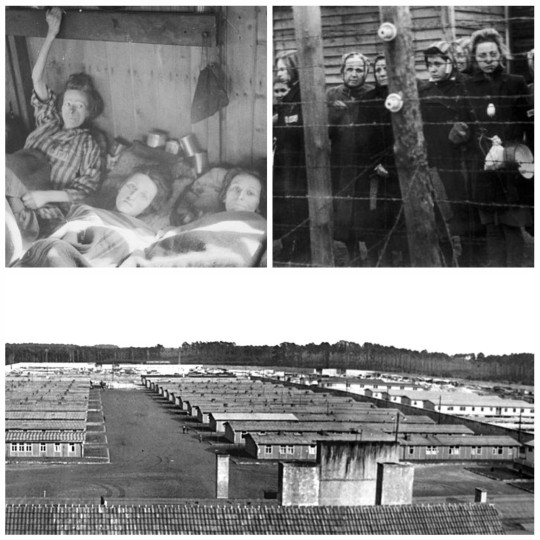
• Ravensbrück Concentration Camp
Ravensbrück was a German concentration camp exclusively for women from 1939 to 1945, located in northern Germany, 90 km (56 mi) north of Berlin at a site near the village of Ravensbrück (part of Fürstenberg/Havel).
Construction of the camp began in November 1938 by the order of the SS leader Heinrich Himmler and was unusual in that it was intended exclusively to hold female inmates. Ravensbrück first housed prisoners in May 1939, when the SS moved 900 women from the Lichtenburg concentration camp in Saxony. Eight months after the start of World War II the camp's maximum capacity was already exceeded. It underwent major expansion following the invasion of Poland. By the summer of 1941 with the launch of Operation Barbarossa an estimated total of 5,000 women were imprisoned, who were fed gradually decreasing hunger rations. By the end of 1942, the inmate population of Ravensbrück had grown to about 10,000. The greatest number of prisoners at one time in Ravensbrück was probably about 45,000. Between 1939 and 1945, some 130,000 to 132,000 female prisoners passed through the Ravensbrück camp system. According to Encyclopædia Britannica, about 50,000 of them perished from disease, starvation, overwork and despair; some 2,200 were killed in the gas chambers. During the first year of their stay in the camp, from August 1940 to August 1941, roughly 47 women died. During the last year of the camp's existence, about 80 inmates died each day from disease or famine-related causes.
Although the inmates came from every country in German-occupied Europe, the largest single national group in the camp were Polish. In the spring of 1941, the SS authorities established a small men's camp adjacent to the main camp. The male inmates built and managed the gas chambers for the camp in 1944. There were children in the camp as well. At first, they arrived with mothers who were Romani or Jews incarcerated in the camp or were born to imprisoned women. There were few children early on, including a few Czech children from Lidice in July 1942. Later the children in the camp represented almost all nations of Europe occupied by Germany. Between April and October 1944 their number increased considerably, consisting of two groups. One group was composed of Romani children with their mothers or sisters brought into the camp after the Romani camp in Auschwitz-Birkenau was closed. The other group included mostly children who were brought with Polish mothers sent to Ravensbrück after the collapse of the Warsaw Uprising of 1944. Most of these children died of starvation.
Ravensbrück had 70 sub-camps used for slave labour that were spread across an area from the Baltic Sea to Bavaria. Among the thousands executed at Ravensbrück were four members of the British World War II organization Special Operations Executive (SOE): Denise Bloch, Cecily Lefort, Lilian Rolfe and Violette Szabo. Other victims included the Roman Catholic nun Élise Rivet, Elisabeth de Rothschild (the only member of the Rothschild family to die in the Holocaust), Russian Orthodox nun St. Maria Skobtsova, the 25-year-old French Princess Anne de Bauffremont-Courtenay, Milena Jesenská, lover of Franz Kafka, and Olga Benário, wife of the Brazilian Communist leader Luís Carlos Prestes. Among the survivors of Ravensbrück was author Corrie ten Boom, arrested with her family for harbouring Jews in their home in Haarlem, the Netherlands. SOE agents who survived were Yvonne Baseden and Eileen Nearne, who was a prisoner in 1944 before being transferred to another work camp and escaping. Englishwoman Mary Lindell and American Virginia d'Albert-Lake, both leaders of escape and evasion lines in France, survived. Ravensbrück survivors who wrote memoirs about their experiences include Gemma La Guardia Gluck, sister of New York Mayor Fiorello La Guardia, as well as Germaine Tillion, a Ravensbrück survivor from France who published her own eyewitness account of the camp in 1975. Approximately 500 women from Ravensbrück were transferred to Dachau, where they were assigned as labourers to the Agfa-Commando; the women assembled ignition timing devices for bombs, artillery ammunition and V-1 and V-2 rockets.
Camp commandants included SS-Standartenführer Günther Tamaschke from May 1939 to August 1939, SS-Hauptsturmführer Max Koegel from January 1940 till August 1942, and SS-Hauptsturmführer Fritz Suhren from August 1942 until the camp's liberation at the end of April 1945. Besides the male Nazi administrators, the camp staff included over 150 female SS guards assigned to oversee the prisoners at some point during the camp's operational period. Ravensbrück also served as a training camp for over 4,000 female overseers. The technical term for a female guard in a Nazi camp was an Aufseherin. The women either stayed in the camp or eventually served in other camps.
When a new prisoner arrived at Ravensbrück she was required to wear a colour-coded triangle (a winkel) that identified her by category, with a letter sewn within the triangle indicating the prisoner's nationality. For example, Polish women wore red triangles, denoting a political prisoner, with a letter "P" (by 1942, Polish women became the largest national component at the camp). Soviet prisoners of war, and German and Austrian Communists wore red triangles; common criminals wore green triangles; and Jehovah's Witnesses were labelled with lavender triangles. Prostitutes, Romani, homosexuals, and women who refused to marry were lumped together, with black triangles. Jewish women wore yellow triangles but sometimes, unlike the other prisoners, they wore a second triangle for the other categories. For example, quite often it was for rassenschande ("racial pollution"). Some detainees had their hair shaved, such as those from Czechoslovakia and Poland, but other transports did not. In 1943, for instance, a group of Norwegian women came to the camp (Norwegians/Scandinavians were ranked by the Nazis as the purest of all Aryans). None of them had their hair shaved. Between 1942 and 1943, almost all Jewish women from the Ravensbrück camp were sent to Auschwitz in several transports, following Nazi policy to make Germany Judenrein (cleansed of Jews). Based on the Nazis' incomplete transport list Zugangsliste, documenting 25,028 names of women sent by Nazis to the camp, it is estimated that the Ravensbrück prisoner population's ethnic structure comprised: Poles 24.9%, Germans 19.9%, Jews 15.1%, Soviets 15.0%, French 7.3%, Romani 5.4%, other 12.4%. The Gestapo further categorised the inmates as: political 83.54%, anti-social 12.35%, criminal 2.02%, Jehovah's Witnesses 1.11%, rassenschande (racial defilement) 0.78%, other 0.20%.
One form of resistance was the secret education programmes organised by prisoners for their fellow inmates. All national groups had some sort of programme. The most extensive were among Polish women, wherein various high school-level classes were taught by experienced teachers. In 1939 and 1940, camp living conditions were acceptable: laundry and bed linen were changed regularly and the food was adequate, although in the first winter of 1939/40, limitations began to be noticeable. Not long after conditions quickly deteriorated. Starting in the summer of 1942, medical experiments were conducted without consent on 86 women; 74 of them were Polish inmates. Two types of experiments were conducted on the Polish political prisoners. The first type tested the efficacy of sulfonamide drugs. These experiments involved deliberate cutting into and infecting of leg bones and muscles with virulent bacteria, cutting nerves, introducing substances like pieces of wood or glass into tissues, and fracturing bones. Out of the 74 Polish victims, called Kaninchen, Króliki, Lapins, or Rabbits by the experimenters, five died as a result of the experiments, six with unhealed wounds were executed, and (with assistance from other inmates) the rest survived with permanent physical damage.
All inmates were required to do heavy labor ranging from strenuous outdoor jobs to building the V-2 rocket parts for Siemens. The SS also built several factories near Ravensbrück for the production of textiles and electrical components. The women forced to work at Ravensbrück concentration camp's industries used their skills in sewing and their access to the factory to make soldiers' socks. They purposely adjusted the machines to make the fabric thin at the heel and the toes, causing the socks to wear prematurely at those places when the German soldiers marched. For the women in the camp, it was important to retain some of their dignity and sense of humanity. Therefore, they made necklaces, bracelets, and other personal items, like small dolls and books, as keepsakes. These personal effects were of great importance to the women and many of them risked their lives to keep these possessions. In January 1945 the SS also transformed a hut near the crematorium into a gas chamber where the Germans gassed several thousand prisoners before the camp's liberation in April 1945; in particular they killed some 3600 prisoners from the Uckermark police camp for "deviant" girls and women, which was taken under the control of the Ravensbrück SS at the start of 1945. In January 1945, prior to the liberation of the remaining camp survivors, an estimated 45,000 female prisoners and over 5,000 male prisoners remained at Ravensbrück, including children and those transported from satellite camps only for gassing, which was being performed in haste.
With the Soviet Red Army's rapid approach in the spring of 1945, the SS leadership decided to remove as many prisoners as they could, in order to avoid leaving live witnesses behind who could testify as to what had occurred in the camp. At the end of March, the SS ordered all physically capable women to form a column and exit the camp in the direction of northern Mecklenburg, forcing over 24,500 prisoners on a death march.Some 2,500 ethnic German prisoners remaining were released, and 500 women were handed over to officials of the Swedish and Danish Red Cross shortly after the evacuation. On April 30th, 1945, fewer than 3,500 malnourished and sickly prisoners were discovered alive at the camp when it was liberated by the Red Army. The survivors of the death march were liberated in the following hours by a Soviet scout unit. The SS guards, female Aufseherinnen guards and former prisoner-functionaries with administrative positions at the camp were arrested at the end of the war by the Allies and tried at the Hamburg Ravensbrück trials from 1946 to 1948. 16 of the accused were found guilty of war crimes and crimes against humanity and sentenced to death.
On the site of the former concentration camp there is a memorial today. In 1954, the sculptor Will Lammert was commissioned to design the memorial site between the crematorium, the camp wall, and Schwedtsee Lake. Up to his death in 1957, the artist created a large number of sculpted models of women. Since 1984, the former SS headquarters have housed the Museum des antifaschistischen Widerstandskampfes (Museum of Anti-fascist Resistance). After the withdrawal from Germany of the Soviet Army, which up to 1993 had been using parts of the former camp for military purposes, it became possible to incorporate more areas of the camp into the memorial site. Today, the former accommodation blocks for the female guards are a youth hostel and youth meeting centre.
#second world war#world war 2#world war ii#history#wwii#german history#holocaust#nazi germany#long post#womens history#women in history
27 notes
·
View notes
Text
There are literally SO many other characters to ship people with, WHY MAX?????????
Another day, another fucking Pip x Max fic on the ao3 tag 🤮
Atp I've just grown accustomed to the fact that people are gonna ship that freak with Pip and can't do anything about it because those shippers get highly defensive over that nasty ship. I'm just saying but if you need to go to extreme lengths to defend shipping Pip with a rapist, then maybe the ship is just awful 🤷♀️ (because it literally is. Fuck Max Hastings).
#Anti Max Hastings#Max x casket 2024#agggtm#a good girl's guide to murder#max hastings#pippa fitz amobi
21 notes
·
View notes
Photo

La Petite Anglaise
She parachuted behind enemy lines.
Violette Szabo was a British spy who parachuted into France twice to collect valuable intelligence and paid the highest price for her exceptional bravery.
Born in Paris in 1921, Violette’s mother was French and her father was English. During the Great Depression, her parents couldn’t afford to care for her and she lived with an aunt in Picardy. Finally when she was 11 the family was reunited in London. Violette was a tomboy and natural athlete who loved to compete with her four brothers. Her father taught her how to shoot at a young age, and she was known to be fearless.
Violette grew up in Brixton, and was popular at school due to her bubbly, fun-loving personality and good sense of humor. French was her first language, but she spoke English with a Cockney accent, and also displayed the impish Cockney sense of humor. She left school at age 14 and went to work for a French lingerie company, and then Woolworths.
When WW2 broke out in 1939 Violette was selling perfume in a department store. She immediately joined the Women’s Land Army, a volunteer force of agricultural workers to replace men who were called up to battle, and was sent to pick strawberries in Hampshire, then to work at an armaments factory in London.
In 1940 Violette’s French mother sent her to a Bastille Day parade in London, and told her to bring a homesick French soldier home for dinner. She met Etienne Szabo, a decorated non-commissioned officer in the French Foreign Legion and after a whirlwind 42-day romance, they got married. She was 19, he was 31. They had a week honeymoon before Etienne left to join the Free French fight against the pro-German Vichy regime.
Violette became a switchboard operator in central London during the German blitz. Bored with her job and itching to join the fight, she joined the Auxiliary Territorial Service, the women’s branch of the British Army. She underwent an intensive training program in Leicester and was then assigned to an Anti-Aircraft Regiment. Soon after she discovered she was pregnant, so she returned to London where her daughter Tania was born in June 1942. Three months later, Violette learned that her husband had been killed in action, fighting the Axis powers in North Africa, without ever meeting his baby daughter.
Violette was more determined than ever to fight the enemy that killed her husband. Speaking both English and French without an accent, she was recruited to train as a field agent in the Special Operations Executive, a British intelligence and espionage agency. She was given security clearance and went to a special training school in the Scottish Highlands in the summer of 1943 where she studied navigation, weapons and demolition. She passed the course, and went on to more advanced training at the SOE “finishing school” in Hampshire, where she learned cryptography, weaponry, survival skills, how to evade capture, and how to escape if captured. British journalist Max Hastings wrote that Violette was “adored by the men and women of SOE both for her courage and endless infectious Cockney laughter.”
The last stage in training was parachute jumping, which was taught at an airport near Manchester. Violette badly sprained her ankle on her first jump, but after several weeks to recover she tried again and passed.
On April 5, 1944, Violette was flown from a Royal Air Force station in Bedfordshire in a B-24 Liberator bomber and parachuted into German-occupied France. She had a fake identity as a French secretary, and a mission to act as a courier for the Resistance. Her fellow anti-Nazi fighters called her “La Petite Anglaise” (The Little English Woman) as she was only five feet tall. She gathered intelligence and carried out reconnaissance, and the information she collected helped the Allies identify German bombing targets. She returned to England, and was soon being sent on an even more dangerous mission. Knowing the dangers, she made a will and cried as she said goodbye to her daughter and her mother.
Violette parachuted back into France on June 8, 1944, right after the D-Day landings. Unfortunately, this trip was not as successful. She was in a car with two members of the Resistance when they hit a German roadblock, which led to a shoot-out. Violette was wounded and captured. Despite being injured, she was taken to the German military prison, where she was tortured, but refused to give up any information about her associates. She was seen twice a day limping across the courtyard to face brutal interrogations. As her health worsened, Violette was sent to the notorious Ravensbruck concentration camp for women in Germany. While there, she was beaten, starved, and possibly sexually assaulted. Finally, in early 1945, Violette was taken to “execution alley” and shot in the head. She was 23 years old.
After her death, Violette was honored by her country with the presigious George Cross, a medal for bravery created by George VI in 1940. Violette remains one of only four women in history to receive the George Cross. It was presented to her five year old daughter Tania in 1947. Violette was also awarded the Croix de Guerre by the French government in 1947. She and her husband Etienne were the most decorated married couple of World War II, and their exceptional bravery cost them their lives.
After the war, Violette’s parents emigrated to Australia with Tania. In 1958, Violette’s incredible story was made into a movie, “Carve Her Name With Pride.” Tania described her mother’s life as “short but lived to the full, with. much happiness, joy, some deep sadness, and great endeavor.”
For bravely parachuting into Occupied France – twice – and helping defeat the Germans, we honor Violette Szabo as this week’s Thursday Hero.
Accidental Talmudist
28 notes
·
View notes
Text
Ignition.
It’s a beautiful day. The rising sun has sent all but the most foolish and foolhardy into their hives until dusk, as usual. Which is why it’s perfect for making dead drops of your deconstructive literature in your hometown. There’s a little place you stash them, right near the town square, and there’s a brick you flip around whenever you make a drop, carved to indicate that something is there for those that look. And whenever you go back and look they’re gone, so you know some people have found them. In fact you’ve met a scant few of them, and it gives you hope that what you’re doing matters. A satchel full of the booklets is resting at your hip right now, and you’re hoping that if any of your topics really strikes a chord, it’ll be this one.
As usual, well... This is Beforus. It’s idyllic. Almost unnervingly so. But right as you’re about to open up your little stash, having just ducked out of your alley shortcut, Something happens.
An imperial drone spots you.
Of course, you don’t know that right away. No alarm blares. Your hand is buried in your bag when you hear the thud of it landing right by you. Right by you. It’s only feet away, and saying you jumped is an understatement. It sort of towers over you, you’ve never been this close to one before you realize, and it’s staring you down. Very briefly you consider reaching for the pocket firearm Meenah sent you, but you can’t imagine that doing... Well, goddamn anything really.
“CITIZEN SUSPECTED FOR ILLEGAL ACTIVITY.” It doesn’t really have facial expressions, and its voice is emotionless. It’s sort of inscrutable. “YOU ARE BEING DETAINED, DO NOT RESIST.” It reaches one of its huge, beefy arms for you, and you sidestep it in a panic. You’re pretty sure it doesn’t like that. As confident and collected as you like to usually act, opening your mouth and speaking is the hardest it’s ever been.
“I’m not going anywhe-”
“DO NOT RESIST. THIS IS YOUR FINAL WARNING.” You wince, and when the hulking frame moves to take a step, every single warning bell in your body blares at max volume. Retreat, Porrim. Now. Closing the distance, it reaches for you again and you react by sprinting under its arm and past it, booklets fluttering out of your satchel. You book it deeper into town, hoping you can duck into another alley before it’s caught up and make it lose track of you. You’re no athlete, but your gifts let you move faster than most trolls who practice for it.
The drone catches up in fifteen seconds.
And you don’t even hear it behind you as it gives chase, not until it’s nearly on you and the sound of burning thrusters makes you look over your shoulder in wild confusion. Its arm is outstretched, and in your dumbfounded shock you stop to try to duck under it, or step to the side, or grab it and hold it at bay, or SOMETHING. All you manage to accomplish is letting it ram into you full speed and crush you against the wall of a building.
When you come to a few seconds later, it’s just staring you down it seems like, making that heaving motion they do like they’re always heavily breathing. You’re making the same motion, actually, because you are heavily breathing. You’re in so much pain. Everything got crushed. This “hand” is as big as your torso, and in its haste to get you it was imprecise. Its sharp thumb is jammed through your side, having gored a chunk out of it. You’re in so much pain. As a Beforan, injuries like this are basically unheard of. You’ve had some scrapes. But you’ve never seen so much of your blood leave you so quickly, and that’s with the wound plugged. Half of its hand is green. Half of your body is green. The ground around you is green. You’re in so much pain. You can hear its other fingers scraping through the wall behind you, further worsening the structural damage your impact caused. You’re familiar with the feeling of a broken rib. You’re familiar with the feeling of most of your rubs being broken at the same time. You were not, until this moment, familiar with the feeling of having your shattered rib cage squished even further. You’re in so much pain. It pales in comparison, but with what few thoughts you can have clearly you can’t help but be reminded that the only time you’ve even come close to feeling this indescribably awful was that accident right before you discovered you were a- Oh. That’s right.
You’re a fucking rainbow drinker.
Your arms have been free this whole time. It’s looking at you, glowering, yelling something about taking you somewhere for something. You can’t understand it. You can’t understand anything right now. But as the adrenaline hits, all at once with a snarl you raise both of your arms and all your rage, your fear, your pain is channeled into turning on your glow. And it’s bright, like you’re the epicenter of a flashbang. Your skin burns now and the light fades fast, but the pain blends in with everything else by the time you’ve brought your fists down on either side of the top of the drone’s arm, shattering its carapace and splashing black blood onto your arms.
By the time it’s over the stun of the light, the drone is reeling slightly from having its limb crushed, and that’s all the opportunity you need. With its grip slightly loosened you grab on to the arm, barely even feeling the jagged edges slice your hands, and push it away from you, causing even more of your blood to gush out, more than a human could ever safely lose. And then you bend it away from you, the way the drone’s elbow isn’t supposed to go. It’s sort of a satisfying crunching noise when you break its joint, burning sensation resurfacing in your muscles. And as you brace, leg coming forward, and the drone braces against the pain, knee hitting the ground, you twist brutally, like you’re turning the wheel of a ship, and snap the limb clean off.
Every single one of your muscles feels like it would implore you to stop moving. You’ve never wanted less to stop moving. With the creature, the monster, rearing back, you flip the arm you’ve stolen and get a solid grip on what used to be the elbow. The blood is flowing out of it like a storm drain as you shakily lift it up. And then you bring it down at an angle, flat back of the hand bouncing off of its head, cracking it a little and breaking a few of the spikes. You carry the momentum into steadying it directly over you and then bring it down again, straight down, on top of the drone’s skull. And then again. And then again. And again. And again. Again. Again. Again. You haven’t had a single thought since you crashed your own fists into it, but you realize now that you’re growling something out, and you use it to punctuate your last few blows.
“I’M! NOT! GOING! ANYWHERE!” The hand on your impromptu weapon has been demolished, beaten down to a stub, and the end of the limb below the wrist is doing little better. As you lift it for the last time, you see the head, crumpled flat in the crater you’ve created between the drone’s shoulders and bereft of all spikes. Finally you drop your bludgeon, and you start thinking again, you start thinking faster than you can keep up with. You can’t stay here. You can’t stay on this planet. You’re sure that more drones will be on their way soon enough, however they signal each other, but surveying the scene you see your booklets, half of them ruined with either black or green blood. You see the poor building, which you’re too delirious to be able to glean what it’s even the wall of. Through your bleary eyes, you think you see commotion stirring through some of the windows around you. You can’t just leave the scene like this.
You scoop up some of your aggressor’s blood. Enough of the wall is still flat that it will make a fine writing surface. You drag your hand across it to make four short, large words. And then sign it off in your own blood underneath. You don’t normally quirk for this alias. But you think it’s appropriate here.
You don’t run away from the conflict site. You don’t jog. But you’ve got enough strength left in you not to limp for a while, even when all the pain comes flooding back. When the few trolls with sungoggles finally catch wind of the commotion and step outside, they see a dead imperial drone, kneeling, missing an arm. A disaster of two colors of blood. Some loon’s bold anti-empire booklets leaking out of an abandoned satchel. And a brick wall, with a message.
DO+
NO+T
GO+
QUIETLY
-M
#blood //#violence //#gore //#injury //#idk porrim gets real fucked up#Action Post#ask to tag /././#Fire on Beforus
7 notes
·
View notes